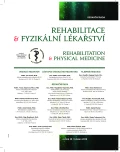Telerehabilitation for Patients with a Balance Disorder Who are Recovering from a Stroke
Authors:
M. Janatová 1,2; M. Šollová 2; O. Švestková 1
Authors‘ workplace:
Klinika rehabilitačního lékařství 1. LF UK a VFN v Praze, přednostka prof. MUDr. O. Švestková, Ph. D.
1; Společné pracoviště biomedicínského inženýrství FBMI ČVUT a 1. LF UK
2
Published in:
Rehabil. fyz. Lék., 25, 2018, No. 1, pp. 28-33.
Category:
Case Report
Overview
The article describes the importance of telerehabilitation and provides a description of its application in practice. As a practical example of a feasible and affordable telerehabilitation approach in the domestic context, we present the case report of a patient with whom we have used, as a telerehabilitation intervention, the interactive Home balance system. The system was used for balance training, utilizing a stabilometric platform and visual feedback as well as the Skype application for online video calls.
The overall benefits, including sustainability of the effect of the therapy, were objectively verified using posturographic examination and standardized tests. Following therapy, the patient measured improvement in the Berg Balance Scale, Mini-BESTest and Functional Independence Measure (FIM) standardized tests and in posturographic examination. The improvement remained partially sustained even after four weeks without therapy. Based on a structured questionnaire completed by the patient, the positive subjective impression of the patient was also ascertained.
Keywords:
telerehabilitation, visual feedback, balance disorder, stroke
Sources
1. ADEY-WAKELING, Z., CROTTY, M.: Upper limb rehabilitation following stroke: current evidence and future perspectives. Aging Health, 2013, č. 6, s. 629-647.
2. BRIENZA, D., MCCUE, M.: Introduction to telerehabilitation. Telerehabilitation. Springer, 2013, s. 1-11.
3. BRUGET, N.: Využití zpětné vazby v rehabilitaci pacientů s poruchami chůze po cévní mozkové příhodě. Rehabil. fyz. Lék., roč. 22, 2015, č. 2, s. 70-78.
4. CORBETTA, D., IMERI, F., GATTI, R.: Rehabilitation that incorporates virtual reality is more effective than standard rehabilitation for improving walking speed, balance and mobility after stroke: a systematic review. Journal of Physiotherapy, 2015, č. 3, s. 117-124.
5 DAREKAR, A., FADYEN, B., LAMONTAGNE, A., FUNG, J.: Efficacy of virtual reality-based intervention on balance and mobility disorders post-stroke: a scoping review. Journal of Neuroengineering and Rehabilitation, 2015, č. 1, s. 46-60.
6. HAILEY, D., ROINE, R., OHINMAA, A., DENNETT, L.: Evidence of benefit from telerehabilitation in routine care: A systematic review. Journal of Telemedicine and Telecare, 2011, č. 6, s. 281-287.
7. HUIJGEN, B., VOLLENBROEK-HUTTEN, M., ZAMPOLINI, M.: Feasibility of a home-based telerehabilitation system compared to usual care: Arm/hand function in patients with stroke, traumatic brain injury and multiple sclerosis. Journal of Telemedicine and Telecare, roč. 2008, č. 5, s. 249-256.
8. JANATOVÁ, M., TICHÁ, M., MELECKÝ, R. , HÁNA, K., ŠVESTKOVÁ, O., JEŘÁBEK, J.: Pilotní studie využití tenzometrické plošiny v domácí terapii poruch rovnováhy. Česká a slovenská neurologie a neurochirurgie, 2016, č. , s. 591-594.
9. LI, Z., XIU-GUO, H., SHENG, J., SHAO-JUN, M.: Virtual reality for improving balance in patients after stroke: A systematic review and meta-analysis. Clinical Rehabilitation, 2016, č. 5, s. 432-440.
10. SEELMAN, K., HARTMAN, L.: Telerehabilitation: policy issues and research tools. International Journal of Telerehabilitation, 2009, č. 1, s. 37-48.
11. STŘEDA, L., HÁNA, K.: eHealth a telemedicína..GRADA, 2016, s. 92-94.
12. VERAS, M., KAIRY, D., ROGANTE, M., GIACOMOZZI, C., SARAIVA, S.: Scoping review of outcome measures used in telerehabilitation and virtual reality for post-stroke rehabilitation. Journal of Telemedicine and Telecare, 2016, č. 6, s. 567-587.
Labels
Paediatric neurology Paediatric rheumatology Physiotherapist, university degree Neurology Orthopaedic prosthetics Rehabilitation Rheumatology Sports medicineArticle was published in
Rehabilitation & Physical Medicine

2018 Issue 1
- Metamizole vs. Tramadol in Postoperative Analgesia
- Memantine in Dementia Therapy – Current Findings and Possible Future Applications
- Memantine Eases Daily Life for Patients and Caregivers
- Metamizole at a Glance and in Practice – Effective Non-Opioid Analgesic for All Ages
- Advances in the Treatment of Myasthenia Gravis on the Horizon
Most read in this issue
- Psoas Muscle and Possibilities to Influence It
- Modern Manual Techniques the Treatment of Scars
- Treatment of Multiple Sclerosis from the Point of View of Rehabilitation
- Quality of Upper Extremity Skills Test: Practical Utility in Occupational Therapy in Children with Cerebral Palsy
